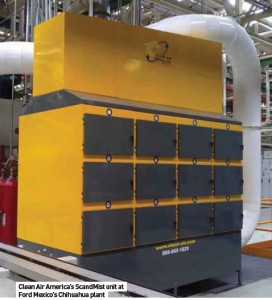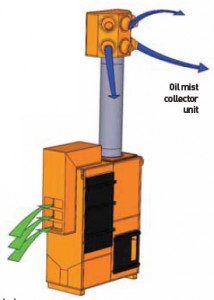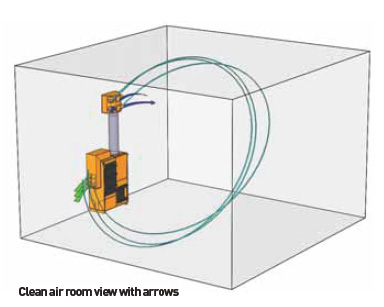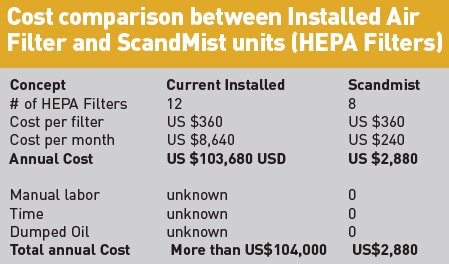Clean Air America tells AMS about the process involved in its assessment and improvement of oil mist filter efficiency at Ford Mexico’s Chihuahua manufacturing plant.

The faclity in Chihuahua manufactures 2.0 and 2.3-litre Duratec engines, which meet the rising consumer demand for smaller and more fuel-efficient engines. These engines are used in the Ford Focus, Fiesta, Explorer, Ranger, Escape, and Lobo models. The 727,000 sq ft plant sits on 247 acres, was opened in 1983 and manufactures over 400,000 engines per year.
The situation
Ford Chihuahua employs various grinding machine centres each with an oil mist filtration unit that utilizes nit mesh filters and bag filters as pre filters, and HEPA H11 filters as the last stage of filtration to clean the air in the centres. These oil mist filtration units were not performing adequately and had very low efficiency on filtration, as showcased by readings taken with a DustTrack 8532. Visible smoke was coming out from one of the exhaust chimneys located on the roof of the plant. A lot of oil spilled on the surroundings of the filtration equipment. Readings of 2-3 mg/m³ were coming out of the chimney without any of the seven grinders running (for that specific system). Their current filtration unit required a constant filter change (every other week) and very high maintenance.
Clean Air America tested three existing oil mist units. The first, called System 8, was fitted with a collector that had an efficiency of 21%. The existing oil mist unit used nit mesh and labyrinth filters; had one main inlet duct going down the line of machines; had sub ducts, each with a strangle valve attached to machines; had one standalone oil mist unit with three doors; and discharged directly through the roof. The total amount of oil escaping from the system was calculated to be 67kg annually. The type of filters that the current oil mist collector was fitted with had a very low efficiency (21%) on droplets – mist – from machining applications. The concentration from the line of machines was relatively low due to high air volume. The airflow from the machines connected to the oil mist collector was enough.
This was controlled by visual inspections and measurements around the machines. The outlet concentration was not very high due to low inlet concentration. The efficiency of the second oil mist collector – System 17 – was found to be 23%. The existing oil mist unit used nit mesh and labyrinth filters; had one main inlet duct going down the transfer machine; had one standalone oil mist unit with one door; and discharged directly through the roof.
high due to low inlet concentration. The efficiency of the second oil mist collector – System 17 – was found to be 23%. The existing oil mist unit used nit mesh and labyrinth filters; had one main inlet duct going down the transfer machine; had one standalone oil mist unit with one door; and discharged directly through the roof.
The third collector – System 10 – collected oil mist droplets from seven grinding machines. System 10 was found to have a 99.4% efficiency. The existing oil mist unit used nit mesh filters and bag filters as pre-filters. At the last filter stage a Hepa Filter class H11 was used. The unit had one main inlet duct going down the seven CBN grinding machines; had one standalone oil mist unit with three doors; and discharged directly through the roof. The total amount of oil escaping from System 10 through the oil mist collector was 28kg annually.
Clean Air America observed that the bag filter that the oil mist collector is fitted with was made for HVAC applications and not for oil mist collectors. This was why the bag filters and Hepa filters needed to be replaced so often.
Conclusions of study
System 10 is the real problem area due to the extremely high concentration of sub-micron droplets from the seven CBN grinding machines. A measurement was taken of the inlet concentration on the system and found that almost all oil mist droplets are 1μm or smaller in droplet size. Catching these oil droplets with bag filters is impossible. Plus, you don’t have any ability to drain out the collected oil. The filter media in the bag filters will very quickly get saturated and breakthrough mist will occur. The high amount of oil after the bag filters will destroy the Hepa filters. The bag filters and Hepa filters were having to be changed every one to two weeks, which was very expensive. Plus the machines needed to be stopped prior to the exchange of filters.
 System 10 had 12 bag filters and 12 Hepa filters installed and if they were to be replaced 12 times every year the cost would be approximately: 12 Hepa-Filters x $300 approx. x 24 changes = approx. $86,400; 12 Bag filters x $90 approx x 24 changes = $25,920 approx. plus changing time, stop time of the machines and waste disposal. Regarding the airflow from the seven grinding machines, Clean Air noticed that when the roof of the machines opened, lots of fine oil mist raised up into the workshop. We suggested the airflow should be raised to 7500-8000 m3/h to get better pressure in the machine enclosures.
System 10 had 12 bag filters and 12 Hepa filters installed and if they were to be replaced 12 times every year the cost would be approximately: 12 Hepa-Filters x $300 approx. x 24 changes = approx. $86,400; 12 Bag filters x $90 approx x 24 changes = $25,920 approx. plus changing time, stop time of the machines and waste disposal. Regarding the airflow from the seven grinding machines, Clean Air noticed that when the roof of the machines opened, lots of fine oil mist raised up into the workshop. We suggested the airflow should be raised to 7500-8000 m3/h to get better pressure in the machine enclosures.
The Solution
Clean Air recommended a bank of four Scandmist MA 200R special oil mist collector units to fix the problem. The Scandmist units will have separate fans mounted on top of each module, controlled by a frequency inverter and pressure sensor. The use of the pressure sensor and frequency inverter allows an even extraction across the complete ductwork which, once set at best performance, will increase or decrease the fan speeds automatically according to the condition of filters. The units will produce 8,000 m3/h of extraction and oil mist separation. The cleaned air will be discharged through the roof. ScandMist oil mist collectors are designed to remove oil mist and smoke from the machining floor environment and efficiently separate oil fumes, oil mist, oily dust, and emulsion mist and return clean air to the plant. Mist, smoke and harmful particles such as swarf, bacteria and spores generated by metalworking machines are extracted at source and cleaned through a three-stage process. Clean air is then returned directly to the workshop and exceeds international health and safety standards for maximum exposure limits to metalworking fluids, such as OSHA, NIOSH, HSE, etc. Also, ScandMist offers more than just health and safety resolution. Through a comprehensive product range ScandMist can improve productivity, lower numerous costs, and reduce energy consumption-through a low maintenance and easy-to-install design.

The ScandMist system works to 99.95% efficiency down to submicron particulate level (0.2-0.3 micron). This level of efficiency results in clean air discharge almost always cleaner than the air readings taken outside the factory. The two main filters have a normal life span of up to and over two years dependent on processes, with no maintenance other than periodically to read the gauges. Each installed ScandMist unit is tested and graphs produced which should be left attached to the unit. This gives confidence to management and the workforce and can bu used to support any health and safety inspections, as it can supplement the company’s risk assessment.




































